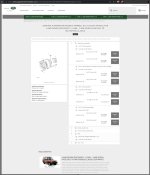I just looked and they're back to $445. I ended up going with a NEW not refurbished 150 amp p38 alt from California alternators. That was a few years ago. Still going strong. I have a dc to dc charger that smartly charges my second battery. Even with that extra load, It keeps the voltage where it should beJust a 2023 update: these are on sale for ~$350 currently.
Hi-output Alternator for D2?
- Thread starter K-rover
- Start date
You are using an out of date browser. It may not display this or other websites correctly.
You should upgrade or use an alternative browser.
You should upgrade or use an alternative browser.
It is worth giving a thought - why would an alternator with the same amount of iron and the same amount of space for copper winding produce twice the current? There are no particular revelations related to that. Most likely, this happens:
(1) The rotor and stator are rewound to have fewer turns but of heavier gauge wire.
(2) The rectifier assembly is upgraded with larger-capacity diodes and heavier heat sink (space is limited).
(3) For (1) and (2) to work, the alternator's rotor must be spinning faster. It can be done on older units, by replacing 67-mm pulley with a newer 55-mm pulley; 55mm is already a pretty small diameter to allow for a long belt life. Essentially, the trade is higher max current capacity for less output at low RPM and idle.
(1) The rotor and stator are rewound to have fewer turns but of heavier gauge wire.
(2) The rectifier assembly is upgraded with larger-capacity diodes and heavier heat sink (space is limited).
(3) For (1) and (2) to work, the alternator's rotor must be spinning faster. It can be done on older units, by replacing 67-mm pulley with a newer 55-mm pulley; 55mm is already a pretty small diameter to allow for a long belt life. Essentially, the trade is higher max current capacity for less output at low RPM and idle.
Normally more current comes from switching from STAR to DELTA..It is worth giving a thought - why would an alternator with the same amount of iron and the same amount of space for copper winding produce twice the current? There are no particular revelations related to that. Most likely, this happens:
(1) The rotor and stator are rewound to have fewer turns but of heavier gauge wire.
(2) The rectifier assembly is upgraded with larger-capacity diodes and heavier heat sink (space is limited).
(3) For (1) and (2) to work, the alternator's rotor must be spinning faster. It can be done on older units, by replacing 67-mm pulley with a newer 55-mm pulley; 55mm is already a pretty small diameter to allow for a long belt life. Essentially, the trade is higher max current capacity for less output at low RPM and idle.
... and you don't lose anything?Normally more current comes from switching from STAR to DELTA..
I would think if you could get a higher magnetic flux out of the rotor along with fewer/heavier windings in the stator you would be able to get more amps/power out of the alternator at a fixed speed. The trick there, of course, would be to get more flux out of the rotor. If there is room to add copper to the rotor I would think it's do-able without necessarily sacrificing low-speed performance. But I don't think most alternators leave much room anywhere.It is worth giving a thought - why would an alternator with the same amount of iron and the same amount of space for copper winding produce twice the current? There are no particular revelations related to that. Most likely, this happens:
(1) The rotor and stator are rewound to have fewer turns but of heavier gauge wire.
(2) The rectifier assembly is upgraded with larger-capacity diodes and heavier heat sink (space is limited).
(3) For (1) and (2) to work, the alternator's rotor must be spinning faster. It can be done on older units, by replacing 67-mm pulley with a newer 55-mm pulley; 55mm is already a pretty small diameter to allow for a long belt life. Essentially, the trade is higher max current capacity for less output at low RPM and idle.
I am not sure there's room for more magnetic flux. Maybe I am giving the alternator designers too much credit, but my guess is they factor in the core to run within 105-110% of saturation magnetic field. Any further increase inevitably leads to more heat.I would think if you could get a higher magnetic flux out of the rotor along with fewer/heavier windings in the stator you would be able to get more amps/power out of the alternator at a fixed speed. The trick there, of course, would be to get more flux out of the rotor. If there is room to add copper to the rotor I would think it's do-able without necessarily sacrificing low-speed performance. But I don't think most alternators leave much room anywhere.
One can optimize the most output for a specific engine RPM range, however, and that's probably how we see physically smaller alternators in other makes/models produce as much or more current.
1/2 volts = 2x current ... but remember: RPM is the variable. So you can get double the current... but by spinning the alt faster you get your volts back up where they need to be. I am not an Alternator Customization expert, so feel free to factcheck me. Switching from a star to a delta certainly doubles the current while halving the voltage. Given you can put a smaller pulley on it, and given 14v has generally arrived at 1000rpm or more... then the main issues are: how much smaller does your pulley need to be..and how much bigger do your diodes need to be?... and you don't lose anything?
Last edited:
"The two basic stator winding designs are delta wound and wye style. Delta wound are easily identifiable by their shape, as they're triangular. These windings allow for a high current flow at lower RPM. Wye windings resemble the flux capacitor seen in "Back to the Future." These windings are ideal for diesel engines, as they produce higher voltage than delta stators at even lower RPM."
LOL, you don't need to explain what star and delta are in alternator configuration. IF the alternator is of a three-phase design, yes, you get ~1.85x the current and ~0.58x the voltage at the same RPM. It may be sufficient at idle, or it may be not.1/2 volts = 2x current ... but remember: RPM is the variable. So you can get double the current... but by spinning the alt faster you get your volts back up where they need to be. I am not an Alternator Customization expert, so feel free to factcheck me. Switching from a star to a delta certainly doubles the current while halving the voltage. Given you can put a smaller pulley on it, and given 14v has generally arrived at 1000rpm or more... then the main issues are: how much smaller does your pulley need to be..and how much bigger do your diodes need to be?
Note the IF statement. I found one P38A 120-amp unit that is of four-phase design, with the rectifier having 8 diodes. Another, a D1 100-amp unit, had rectifier with empty holes for two diodes, also indicating that four-phase design is not uncommon. I need a moment to consider a four-phase delta-equivalent connection - because nobody does it.
Are they using a higher phase count to keep voltage ripple in check with the high output currents from the alternators? With nothing to smooth it out except for the battery? I bet that could reek havoc on some ECUs.
Don't know - it's a puzzle for me: if you can build a 120A alternator in the 100A alt body, why bother with a 100A variety?Are they using a higher phase count to keep voltage ripple in check with the high output currents from the alternators? With nothing to smooth it out except for the battery? I bet that could reek havoc on some ECUs.
But a four-phase alternator would indeed have less voltage ripple than a three-phase, under the same conditions.
I was watching a vid showing how to convert a wye to a delta [a Toyota alt, I think].. right before I posted thatLOL, you don't need to explain what star and delta are in alternator configuration. IF the alternator is of a three-phase design, yes, you get ~1.85x the current and ~0.58x the voltage at the same RPM. It may be sufficient at idle, or it may be not.
Note the IF statement. I found one P38A 120-amp unit that is of four-phase design, with the rectifier having 8 diodes. Another, a D1 100-amp unit, had rectifier with empty holes for two diodes, also indicating that four-phase design is not uncommon. I need a moment to consider a four-phase delta-equivalent connection - because nobody does it.
[ re:
I saw the 4 pole p38 units as well.
Hmmm.
Last edited:
4 pole should be better - you only gain a factor of 1.4 in current, but you only lose a factor of 1.4 in voltage.I was watching a vid showing how to convert a wye to a delta [a Toyota alt, I think].. right before I posted that
I saw the 4 pole p38 units as well.
Hmmm.
This will throw the tach outta wack. It will also obligate a shorter belt. But otherwise.. It seems like a good way to go.(3) For (1) and (2) to work, the alternator's rotor must be spinning faster. It can be done on older units, by replacing 67-mm pulley with a newer 55-mm pulley; 55mm is already a pretty small diameter to allow for a long belt life. Essentially, the trade is higher max current capacity for less output at low RPM and idle.
Probably helps the regulator last longer as well: smoother voltage ripple (higher RMS voltage as well). But will this impact the tach function? I need to look at how the tach works; is it just pulling off of one winding?4 pole should be better - you only gain a factor of 1.4 in current, but you only lose a factor of 1.4 in voltage.
Additionally, using a later ~120 or 150 amp with the small pulley should work.. but the tach will be off; I wonder if it could be modified with a biasing potentiometer?
I found this "200 amp High Output" that looks an awful lot like a regular housing Marinetti:
https://www.powerbastards.com/proddetail.asp?prod=13725-200-HD1-1
But ~$400? My instinct is rather to buy a known high output custom job for that price and make it fit.
Lunchbox, can you tell us more about these guys?

https://www.powerbastards.com/proddetail.asp?prod=13725-200-HD1-1
But ~$400? My instinct is rather to buy a known high output custom job for that price and make it fit.
Lunchbox, can you tell us more about these guys?

Here is the D2 version, I didn't know it was called a "Tempest"...
 parts.jaguarlandroverclassic.com
parts.jaguarlandroverclassic.com

That text in the image, lower left is:
CFBRPC1A
ENGINE - ALTERNATOR - PETROL - (Tempest) UNIPART
...not sure what that coded id is.
Genuine Alternator (v8) For Land Rover Discovery 2 1998 - 2004 Classic (l318) | Jaguar Land Rover Classic Parts

That text in the image, lower left is:
CFBRPC1A
ENGINE - ALTERNATOR - PETROL - (Tempest) UNIPART
...not sure what that coded id is.
